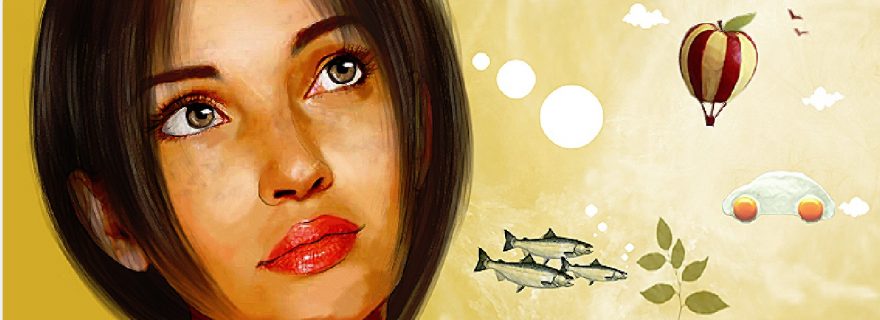Getting creative through food
We tend to think that ‘being creative’ is completely beyond our control, maybe even an inborn talent – you either are or aren’t a creative person. New research indicates that eating the right kinds of food can enhance our creative abilities.
Anecdotal evidence suggests that “creative people” sometimes use food to overcome mental blocks and think deeper about a problem. Steve Jobs – arguably one of the most creative minds of our time – often referred to his fruit diet as the foundation of his success. The idea that eating fruit can influence us like this is certainly not strange when you consider that most fruits – as well as other foods like seaweed, fish, eggs, and soy – are rich in the amino acid tyrosine (4-hydroxyphenylalanine). Tyrosine is the amino acid that can be converted into the neurotransmitter dopamine, which has previously been linked to cognitive control, and creativity in particular.
Together with Lorenza Colzato and Bernhard Hommel, we have now shown for the first time that supplementation with tyrosine can enhance our creative abilities. Specifically, participants came to the lab twice and drank orange juice with either 2 gram placebo or 2 gram tyrosine. The drinks were indistinguishable in taste and color; not even the experimenters knew which compound they were supplying at the time. Later, the participants’ scores were examined for differences between when they drank placebo versus when they drank tyrosine. Because creativity is difficult to quantify, the two main ingredients of creative thinking were measured: divergent and convergent thinking.
Main ingredients of creativity
Divergent thinking is similar to a brainstorming session: many new ideas are generated in a short period of time, but thinking remains at a shallow level where the practicality of these options is not really considered. This process can be measured using the ‘Alternate Uses Task’, where participants are required to think up as many uses as possible for a particular object within a limited amount of time. For example, a pen can be used as a writing utensil, but also as decoration or to stab someone with. The task also takes into account the originality and details of every alternative use.
Convergent thinking , on the other hand, is similar to thinking deeply about a problem until a ‘Eureka’ moment is reached: a problem is presented where one possible solution has to be found. This process can be measured using the ‘Remote Associates Task’, where three seemingly unrelated words are presented, such as ‘man’, ‘glue’, and ‘star’. Participants then have to identify the common link, in this case ‘super’ (because: ‘superman’, ‘superglue’, ‘superstar’).
Tyrosine promotes deep thinking
We found that the participants were better at the Remote Associates Task – reflecting convergent thinking – after they had been supplied with tyrosine compared to placebo. This means that simple changes to our diet – whether that is through eating a banana or through supplementation – can have amazing effects on our ability to think deeply about a problem and finally connect the dots. Steve Jobs describes it well: "Creativity is simply connecting things,” he said. “When you ask creative people how they did something, they feel a little guilty because they didn’t really do it, they just saw something. It seemed obvious to them after a while.”
Tyrosine is not only a cheap, but also a safe way to enhance achieve this: it is impossible to overdose from it (it will simply cease to be converted into dopamine once you have enough) and it does not alter heart rate, blood pressue, mood, or arousal. Thus, tyrosine seems the perfect way to enhance our ability to connect the experiences we have had and the things we have learnt, in order to finally see the solution to a problem. Although, one may consider getting ideas flowing first by using different methods.
Colzato, L.S., de Haan, A., & Hommel, B. (2014). Food for creativity: Tyrosine promotes performance in a convergent-thinking task. Psychological Research. DOI 10.1007/s00426-014-0610-4


2 Comments
An excellent list!They also prdoive a socal function in that they lead to discussion and argument. If one takes an interest in a list then one will have a view as to the order and what has been left out. This view will always vary from everyone else's so it creates a point of discussion online, down the pub, wherever.Whether it's widely accessible lists such as the rich list, the charts or the top 40 favourite comedies or more esoteric ones such as the best prog band of 2010, the same effect is achieved with different sizes of populations.Where would we be without them?!
This sheds a new light on the role of food in the world;
take for instance the Dutch farm made cheese, processed daily! from fresh milk, thus preserving the best of all the 400(!) ingredients in milk - among them tyrosine, and enzymes....that disappear when fresh milk gets pasteurized...
Warning: there are no more than 400 farms in the Netherlands where this very old process is still being honored today.
It also makes us realise how important good food for parents is: for mothers, so they can give the best mother's milk to their infants..and for fathers to be the best they can be.